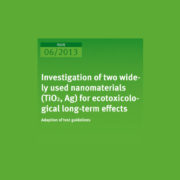Validation of a method to measure bioaccumulation in terrestrial organisms by means of an international ring test
The aim of the project was the validation of a bioaccumulation test with terrestrial organisms (soil dwelling oligochaetes) by an international ring test. The test method was developed taking into account existing methods (UBA-reports 206 03 909 (1997) and 298 64 416 (2001)). A test protocol was prepared and used to run the test. A […]










